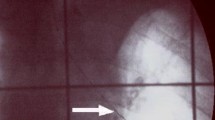Background:
The demand for minimally invasive therapies is increasing in the treatment of small peripheral non-small cell lung cancer (NSCLC).
Patients and Methods:
Twelve patients with T1-2 N0 M0 peripheral NSCLC were treated by high-dose-rate brachytherapy with 192Ir radioactive source.
Results:
A 192Ir source was introduced into the tumors percutaneously in five patients (percutaneous brachytherapy) or transbronchially in seven patients (transbronchial brachytherapy). Whereas irradiation was performed with a single fraction of 20 Gy in percutaneous brachytherapy, it was hypofractionated from 5 × 5 Gy to 2 × 12.5 Gy in transbronchial brachytherapy. Complications were generally mild in all patients, although focal radiation pneumonitis was observed in most patients. Primary recurrence occurred in three patients, including one with a T2 tumor and one treated by brachytherapy as a salvage treatment for recurrence after conformal radiotherapy. When brachytherapy is evaluated as a primary treatment for T1 N0 M0 NSCLC, local control rate is 88.9% and estimated 5-year survival rate is between 60% and 70%.
Conclusion:
Brachytherapy has a potential to be a method to treat peripheral T1 N0 M0 NSCLC.
Hintergrund:
Das Erfordernis minimalinvasiver Eingriffe in der Behandlung kleiner, peripherer, nichtkleinzelliger Bronchialkarzinome (NSCLC) nimmt zu.
Patienten und Methodik:
Zwölf Patienten mit peripherem NSCLC der Stadien T1-2 N0 M0 erhielten eine High-Dose-Rate-Brachytherapie mit radioaktiver 192Ir-Quelle.
Ergebnisse:
Die 192Ir-Quelle wurde bei fünf Patienten über einen perkutanen Zugang (perkutane Brachytherapie) und bei sieben Patienten über einen bronchialen Zugang (transbronchiale Brachytherapie) eingeführt. Bei der perkutanen Brachytherapie wurde die Bestrahlung mit einer Einzeitdosis von 20 Gy durchgeführt, bei der transbronchialen Brachytherapie hypofraktioniert mit 5 × 5 Gy bis 2 × 12,5 Gy. Komplikationen waren im Allgemeinen geringgradig ausgeprägt, allerdings wurde bei den meisten Patienten eine fokale Strahlenpneumopathie beobachtet. Bei drei Patienten trat ein Lokalrezidiv auf (zwei Patienten mit T2-Tumor und ein Patient mit Brachytherapie als Salvage-Behandlung wegen eines Rezidivs nach konventioneller Strahlentherapie). Für die Brachytherapie in der Primarbehandlung von NSCLC des Stadiums T1 N0 M0 beträgt die lokale Kontrollrate 88,9%, und die geschätzte 5-Jahre-Überlebensrate liegt bei 60–70%.
Schlussfolgerung:
Die Brachytherapie ist eine effektive Behandlungsmethode bei peripherem NSCLC des Stadiums T1 N0 M0.
Similar content being viewed by others
Author information
Authors and Affiliations
Corresponding author
Rights and permissions
About this article
Cite this article
Imamura, F., Ueno, K., Kusunoki, Y. et al. High-Dose-Rate Brachytherapy for Small-Sized Peripherally Located Lung Cancer. Strahlenther Onkol 182, 703 (2006). https://doi.org/10.1007/s00066-006-1536-6
Received:
Revised:
DOI: https://doi.org/10.1007/s00066-006-1536-6




